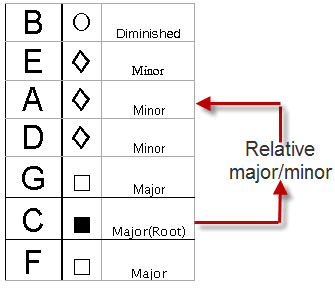Relative majors and minors
Relative Majors and Minors
One of the most common “jumps” up a SeeChord chart is that from a major to its relative minor or vice-versa. First let us see the relationship between the two chords.
Let’s look at the notes that make up a C major chord:
C E G.
Now the notes in the chord A minor, which is said to be the relative minor:
A C E.
Basically, the two chords are very similar. It is worth noticing the the same could be said for E minor with the notes E G and B, but this is not referred to as the relative minor despite its close relationship to C.
A common way to find out a chord’s relative minor is simple to move down 3 semitones. Likewise to find a relative major of a minor chord you would move up 3 semitones. On a SeeChord chart the relative minor is always above the relative major as can be seen here.

Relative major/minor
To see the relative major/minor relationship in action, we need only turn to the two Bach Preludes we have seen before.
[seeChordViewer src=”/content/Application/Relative majors and minors/interpretation1-viewer”]
There are two occasions here where the jump from C major to A minor can be seen. This shows how useful the relative major/minor relationship is to move smoothly away from the root note, often in order to fall through the fifths back towards it again. Here is the extract from Bach’s C minor prelude from Well-Tempered Clavier Book II.
[seeChordViewer src=”/content/Application/Relative majors and minors/relativemajorandminor1-viewer”]
In this example there is a jump from a minor to its relative major in the fm-Ab progression, however, more interestingly there is a “modulation” to the relative major which is why the second half of the chart centres around Eb major (the relative major of C minor!). It is very common for pieces to change key into their relative keys, often within a song the chorus or bridge will be in a relative key, whereas in a symphony or sonata the middle movement is often in a relative key.